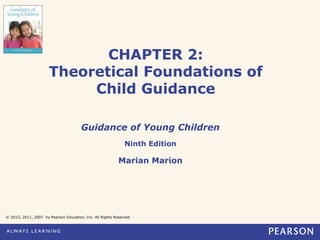
Chapter 2 Theoretical Foundations of Child Guidance
- 1. CHAPTER 2: Theoretical Foundations of Child Guidance Guidance of Young Children Ninth Edition Marian Marion © 2015, 2011, 2007 by Pearson Education, Inc. All Rights Reserved
- 2. Marion. Guidance of Young Children, 9e. © 2015, 2011, 2007 by Pearson Education, Inc. All Rights Reserved 2-2 ECOLOGICAL THEORY FAMILY SYSTEMS THEORY THEORIES FOCUSING ON ‘SYSTEMS’ IN WHICH CHILDREN DEVELOP:
- 3. Marion. Guidance of Young Children, 9e. © 2015, 2011, 2007 by Pearson Education, Inc. All Rights Reserved 2-3 Ecology of Human Development Microsystem Relationships within families and the resources in a neighborhood Mesosystem Connected network formed by different microsystems Exosystem Groups farther away from child (laws, government reform, environmental regulation, social unrest, financial strength or upheaval, business and industry) Macrosystem Values of the culture, type of government, social trends, and major events such as natural disasters Macrosystems affect every other system Chronosystem Degree of change or consistency of various systems over time
- 4. Marion. Guidance of Young Children, 9e. © 2015, 2011, 2007 by Pearson Education, Inc. All Rights Reserved 2-4 Family Systems Theory Boundaries –Family’s ideas about separateness and togetherness Rules –Traditions that families use to guide their interactions with each other –Tell how families deal with persons and systems outside their family Roles –Responsibility or job that a family assigns to different members of a group
- 5. Marion. Guidance of Young Children, 9e. © 2015, 2011, 2007 by Pearson Education, Inc. All Rights Reserved 1-5 Theories Focusing on How Children Construct Knowledge: • Piaget • Dewey • Vygotsky
- 6. Marion. Guidance of Young Children, 9e. © 2015, 2011, 2007 by Pearson Education, Inc. All Rights Reserved 2-6 John Dewey: Children construct knowledge Four primary interests of children Learner’s curiosity • children are naturally inquisitive and interest in their world Creating classroom communities • makes it possible for children to use their curiosity and interests to build ideas, knowledge, and skills
- 7. Marion. Guidance of Young Children, 9e. © 2015, 2011, 2007 by Pearson Education, Inc. All Rights Reserved 2-7 Four Primary Interests of Children (Dewey) Desire to investigate and discover things Need to communicate Joy in construction Artistic expression
- 8. Marion. Guidance of Young Children, 9e. © 2015, 2011, 2007 by Pearson Education, Inc. All Rights Reserved 2-8 Jean Piaget: Children Construct Knowledge by: Interacting with people and objects Children need to be actively involved Taking in new information into one of their existing concepts (assimilation) Changing their existing ideas and concepts to make room for a more refined idea (accommodation)
- 9. Marion. Guidance of Young Children, 9e. © 2015, 2011, 2007 by Pearson Education, Inc. All Rights Reserved 2-9 Piaget’s Stages of Cognitive Development (ages approximate) Sensorimotor Stage −From birth to age 2 −Babies center on their bodies for the first 7-9 months −Gain information about the world through motor activity and coordinating movements Preoperational Stage − 2 to 6 years of age − Now, children can use symbols (words, paintings, beginning writing to show their experience Concrete Operations Stage − 6 to 12 years of age − Logical thinking more refined when using concrete objects Formal Operations Stage − 12 years and forward − Deals with abstract ideas − Can think about different ways to solve problems
- 10. Marion. Guidance of Young Children, 9e. © 2015, 2011, 2007 by Pearson Education, Inc. All Rights Reserved 2-10 Lev Vygotsky: Children Construct Knowledge when Teachers Pay Attention to: Scaffolding A teacher’s changing support as a child develops a new competency or skill Zone of proximal development Space or zone where learning and development takes place Adult-child dialogue or discourse Talking about tasks that a child can accomplish without adult help
- 11. Marion. Guidance of Young Children, 9e. © 2015, 2011, 2007 by Pearson Education, Inc. All Rights Reserved 2-11 Erikson and Maslow are emphasized here Theories Focusing on Psychological, Emotional, and Social Learning Needs:
- 12. Marion. Guidance of Young Children, 9e. © 2015, 2011, 2007 by Pearson Education, Inc. All Rights Reserved 2-12 Erik Erikson’s Stages of Psychosocial Development Trust vs. mistrust –birth-18months –Develop positive trait of trust when needs are met Autonomy vs. shame or doubt –18months-3 years –Encourage independence when possible and safe Initiative vs. guilt –3-5 years –Exploration of their world Industry vs. inferiority –6-12 years –Support as challenges are faced in different systems
- 13. Marion. Guidance of Young Children, 9e. © 2015, 2011, 2007 by Pearson Education, Inc. All Rights Reserved 2-13 Erik Erikson’s Stages of Psychosocial Development Identity vs. role confusion Adolescence Dealing with pressure from the outside world Intimacy vs. isolation Young adulthood Generativity vs. stagnation or self-absorption Middle adulthood Integrity vs. despair Late adulthood
- 14. Marion. Guidance of Young Children, 9e. © 2015, 2011, 2007 by Pearson Education, Inc. All Rights Reserved 2-14 Abraham Maslow: Emphasized Hierarchy of Human Needs: Teachers Can Help Children Meet these Needs Physiological needs Security needs Social needs Esteem needs Self-actualizing needs
Editor's Notes
- Possible replacement for slide 20
